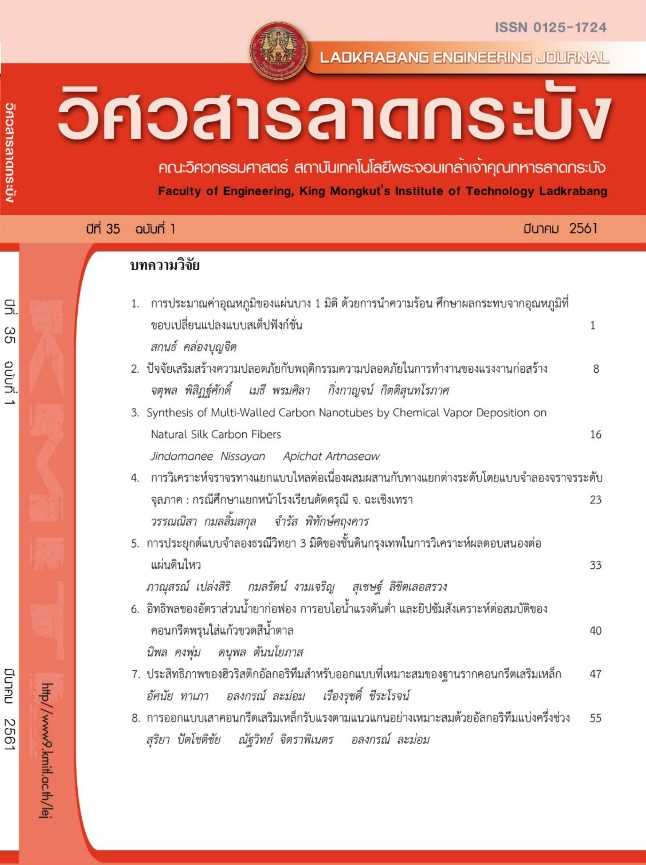Application of Bangkok 3D Geological Model for Seismic Site Response Analysis
Keywords:
3D geological model, Tarlay earthquake, Non-linear site response analysis, Bangkok subsoilAbstract
This paper presents the results of seismic site response analysis of Bangkok subsoil by applying a 3D geological model of Bangkok. The study is based on the assumption that the thickness of soft soil layer can influence the seismic ground response. 1D non-linear ground response analyses are performed with an input of actual ground motion used to happen in Thailand. The shear wave velocities of ground are calculated based on correlations from undrained shear strength and SPT-N value. The results show the peak ground acceleration and spectral acceleration of Bangkok subsoil from Tarlay earthquake. This study shows that Bangkok soft soils have influence on ground amplification factor. The increasing of soft soil thickness affects to the increasing of amplification factor.
References
D. M. Boore, “Estimating Vs(30) (or NEHRP sire classes) from shallow velocity models (depths < 30 m)”, Bulletin of the seismological society of America, Vol. 94(2), pp. 591-597, 2004.
Department of Public Works and Town & Country Planning, “Earthquake Resistance Building Design Standards (DPT standard 1302-52)”, 2009.
H. B. Seed., and I. M. Idriss, “Soil moduli and damping factors for dynamic response analyses”, Retrieved from California, 1970.
H. B. Seed., M. Romo., J. Sun., A. Jaime., and J. Lysmer, “The mexico earthquake of September 19, 1985 – Relationships between soil conditions and earthquake ground motions”, Earthquake Spectra, Vol. 4(4), pp. 687-729, 1988.
K. Ngarmcharoen, “Geotechnical engineering database of Bangkok subsoils for pile foundation design”, Master’s Thesis, Department of Civil Engineering, Faculty of Engineering, Chulalongkorn, 2015.
K. Ngarmcharoen., S. Likitlersuang., and T. Boonyatee, “Development of 3D Geological Modelling for Bangkok Subsoils”, The Twenty-Ninth KKHTCNN Symposium on Civil Engineering, 2016.
M. Vucetic., and R. Dobry, “Effect of soil plasticity on cyclic response” Journal of geotechneical engineering, Vol. 117(1), 1991.
N. Abrahamson., and W. Silva, “Summary of the Abrahamson & Silva NGA ground-motion relations”, Earthquake Spectra, Vol. 24(1), pp. 67-97, 2008.
P. Warnitchai, “Development of seismic design requirements for buildings in Bangkok against the effects of distant large earthquakes”, The 13th world conference on earthquake engineering, Vancouver, 2004.
S. Likitlersuang., and K. Kyaw, “A study of shear wave velocity correlations of Bangkok subsoil”, Obras y Proyectos:Revista de Ingenieria, Vol. 155(7), pp. 27-33, 2010.
[S. Likitlersuang., S. Teachavorasinsakun., C. Surarak., E. Oh., and A.S. Balasubramaniam, “Small Strain Stiffness and Stiffness Degradation Curve of Bangkok Clays”, Soils and Foundations, Vol. 53, No. 4, pp. 498 – 509, 2013.
S. Soralump., B. Kunsuwan., W. Mairaing., and A. Surinkum, “Development of soil database for supporting the development and maintenance of infrastructure : A case study of soft Bangkok clay”, CIVIL ENGINEERING MAGAZINE, pp. 47-69, 2010.
T. Imai, “Correlation of Nvalue with S-wave velocity and shear modulus”, The second European symposium on penetration testing, 1981.
Y. Choi, and J. P. Stewart, “Nonlinear site amplification as function of 30 m shear wave velocity”, Earthquake Spectra, Vol. 21(1), pp. 1-30, 2005.
Y. M. A. Hashash., M. I. Musgrove., J. A. Harmon., D. R. Groholski., C. A. Phillips., and D. Park, “DEEPSOIL 6.1, User Manual”, Board of Trustees of University of Illinois at Urbana-Champaign, Urbana, 2016.
Downloads
Published
How to Cite
Issue
Section
License
The published articles are copyrighted by the School of Engineering, King Mongkut's Institute of Technology Ladkrabang.
The statements contained in each article in this academic journal are the personal opinions of each author and are not related to King Mongkut's Institute of Technology Ladkrabang and other faculty members in the institute.
Responsibility for all elements of each article belongs to each author; If there are any mistakes, each author is solely responsible for his own articles.






